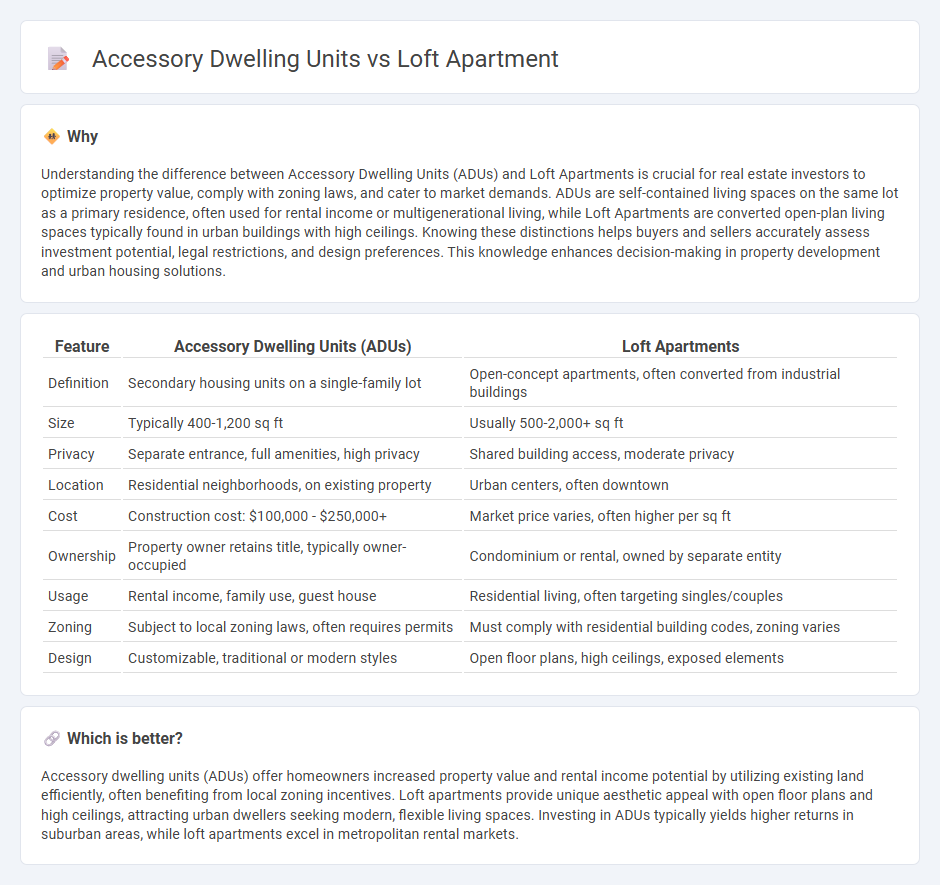
Accessory dwelling units (ADUs) offer a flexible living solution with separate entrances and full amenities, ideal for multigenerational housing or rental income. Loft apartments maximize open floor plans and high ceilings, catering to urban lifestyles with contemporary design and efficient use of space. Explore the benefits and considerations of ADUs and loft apartments to find the perfect real estate investment for your needs.
Why it is important
Understanding the difference between Accessory Dwelling Units (ADUs) and Loft Apartments is crucial for real estate investors to optimize property value, comply with zoning laws, and cater to market demands. ADUs are self-contained living spaces on the same lot as a primary residence, often used for rental income or multigenerational living, while Loft Apartments are converted open-plan living spaces typically found in urban buildings with high ceilings. Knowing these distinctions helps buyers and sellers accurately assess investment potential, legal restrictions, and design preferences. This knowledge enhances decision-making in property development and urban housing solutions.
Comparison Table
| Feature | Accessory Dwelling Units (ADUs) | Loft Apartments |
|---|---|---|
| Definition | Secondary housing units on a single-family lot | Open-concept apartments, often converted from industrial buildings |
| Size | Typically 400-1,200 sq ft | Usually 500-2,000+ sq ft |
| Privacy | Separate entrance, full amenities, high privacy | Shared building access, moderate privacy |
| Location | Residential neighborhoods, on existing property | Urban centers, often downtown |
| Cost | Construction cost: $100,000 - $250,000+ | Market price varies, often higher per sq ft |
| Ownership | Property owner retains title, typically owner-occupied | Condominium or rental, owned by separate entity |
| Usage | Rental income, family use, guest house | Residential living, often targeting singles/couples |
| Zoning | Subject to local zoning laws, often requires permits | Must comply with residential building codes, zoning varies |
| Design | Customizable, traditional or modern styles | Open floor plans, high ceilings, exposed elements |
Which is better?
Accessory dwelling units (ADUs) offer homeowners increased property value and rental income potential by utilizing existing land efficiently, often benefiting from local zoning incentives. Loft apartments provide unique aesthetic appeal with open floor plans and high ceilings, attracting urban dwellers seeking modern, flexible living spaces. Investing in ADUs typically yields higher returns in suburban areas, while loft apartments excel in metropolitan rental markets.
Connection
Accessory dwelling units (ADUs) and loft apartments share a common goal of maximizing living space within existing properties, often contributing to increased urban density and housing affordability. Both ADUs, which are secondary housing units on single-family lots, and loft apartments, characterized by open floor plans and converted industrial spaces, cater to flexible living arrangements and urban dwellers seeking efficient, stylish homes. These housing types also support sustainable development by utilizing underused spaces and reducing urban sprawl.
Key Terms
Open Floor Plan (Loft)
Loft apartments feature open floor plans that maximize space by eliminating interior walls, creating a seamless living, dining, and sleeping area ideal for urban dwellers seeking flexibility and modern aesthetics. Accessory dwelling units (ADUs), while often smaller and separate from the main structure, typically have more defined rooms and may not prioritize an open layout. Explore the benefits of open floor plans in lofts to understand how they optimize space and lifestyle in contemporary housing.
Detached Structure (ADU)
Detached accessory dwelling units (ADUs) provide separate, self-contained living spaces on a single property, offering privacy and flexibility compared to loft apartments typically integrated within existing buildings. ADUs often increase property value and supply additional rental income opportunities, while loft apartments appeal for their open layouts and urban location. Explore the benefits and regulations of detached ADUs to determine the right fit for your housing needs.
Zoning Regulations
Loft apartments often face zoning regulations related to building height, floor area ratio, and occupancy limits, while accessory dwelling units (ADUs) are subject to specific ordinances governing size, setbacks, and owner occupancy requirements. Many municipalities have updated zoning codes to encourage ADU development as a strategy to increase affordable housing stock and optimize land use. Explore the detailed zoning requirements for loft apartments and ADUs to fully understand how regulations impact your property options.
Source and External Links
Franklin Lofts & Flats - Offers chic city living in Baltimore with new one, two, and three-bedroom apartments in a historical building.
City View Loft - Provides historic architecture, premium amenities, and an excellent location in Baltimore with various apartment layouts.
Four Ten Lofts - Features creative lofts in the Bromo Tower Arts District with amenities tailored for artists, including studios and galleries.
 dowidth.com
dowidth.com